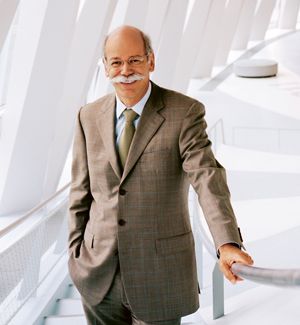You remember Dieter Zetsche. He’s currently top dog at Mercedes-Benz, which makes him the boss at Maybach, too. But, he was also formerly the head of Chrysler, back when it was part of DaimlerChrysler.
He is telling the press that Maybach’s demise is not imminent, that it actually produced about 400 cars last year, not the 146 widely reported in recent news stories, and that 156 of them were delivered in the United States.
He says that Daimler has made enough profit in the past six years to keep it going into the future.
Of course, this is the same guy who ran Chrysler for five years, was promoted to the top spot at DaimlerChrysler and proclaimed – only a year ago – that he had “total confidence in the success” of Chrysler’s recovery plan,
(more after the jump)
and then dumped the company less than two months later.
So, maybe one ought not read too much into what Dr. Z has to say about Maybach.
Unless, of course, you believe in precedent, in which case Zetsche’s praise could be taken as prologue to burying the brand.
There are good reasons to believe that Maybach is going out of business. The current car is the first model produced by the company, and it is based on the previous generation S Class platform. In contrast, Rolls-Royce has a much newer platform. Further, the Maybach’s appearance is not particularly distinctive in comparison to other Daimler brand. The Rolls-Royce and Bentley models are unlike others, distinctive and easily recognizable. Both, of course, have names long associated with top-line luxury, whilst Maybach is best remembered as the manufacturer of engines for the Hindenburg and other Zeppelin airships.
But, there are also compelling reasons why, having made the initial mistake of producing the super-luxury version of the Mercedes-Benz under a different brand name, the company is stuck with continuing to build it. Perhaps the largest is that Kuwaiti investors hold a large chunk of the company’s stock and have considerable influence on its overall management strategies. Mercedes needs to have a super luxury car that is competitive in that Arab and Mid-Eastern markets.
Nonetheless, it’s hard to look at the new Landaulet model without thinking that it’s a cheap way to give the old model a bit of a boost before killing it off. Car makers have been prolonging the life of old models with “special editions” for years, and the Landaulet really offers nothing new, other than a canvas roof.
Maybach has been reported to considering a lower priced model, one that slots into the price range below the current Maybach 57. That would put the brand in a market currently dominated by Bentley, one which will soon see a new Rolls-Royce entrant, as well.
However, entering that market without first introducing a replacement for the current Maybach 57 doesn’t seem to be a workable strategy. The new model would, absent a replacement for the top of the line, even further diminish the waning luster of the 57.
So, Daimler is faced with an expensive strategy if it is to continue the Maybach brand: replace the aging current model and develop a lower priced model, thereby competing across-the-board with BMW’s Rolls-Royce. It could, of course, simply develop a replacement for the 57, but that leaves the brand out of the very lucrative Bentley priced market.
In the last analysis, however, Maybach’s future may actually be quite secure. Killing off the brand would be tantamount to admitting that it was both a mistake and a failure.
Zetsche probably doesn’t want to do that again.

